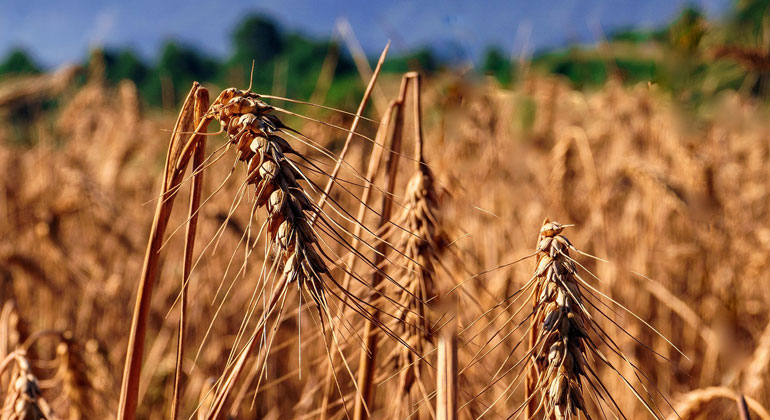Drought in Europe decreases the vegetation’s carbon uptake and crop yields
ICOS, the Integrated Carbon Observation System, has enabled studies that show how the nature in Europe responds to extremely dry conditions, such as the drought in summer 2018.
Results published today in Philosophical Transactions B show, for example, that the vegetation’s carbon sink function was reduced by 18 percent, and crops produced the lowest yields in decades. Since extreme droughts will likely happen much more frequently in the future, the results gain particular importance.
The 2018 summer had the largest ever area in Europe under extreme drought. Temperature records were broken in many regions of Central Europe and the UK, fires broke out in the Nordic countries, and several countries were affected by crop failures.
The 17 study results published today in a special issue of Philosophical Transactions B show how the vegetation in Europe responded to the drought, i.e. how the exchange of carbon between the vegetation and atmosphere is affected. The studies cover areas from Spain to Sweden and Finland, and from Czech Republic through Germany, France and Belgium to the Netherlands and the UK.
Due to the changing climate, extremely hot and dry summers are expected to occur much more frequent in the future. As a result, the areas of crops affected will likely increase considerably, as well. Our drought studies provide crucial knowledge that is needed when trying to minimise such negative effects of climate change.
Forest carbon sinks decreased, crops were lost, and grasslands browned down
According to the results presented, the plants first profited from warm and sunny conditions in spring, but then had not enough water available to their roots when the summer heat wave hit. Grasslands simply “browned-down” during the drought, and many crops produced the lowest yields in decades. “Several studies show that the dryness of the soil affected the plants even more than e.g. the high temperature and the low humidity of the air”, explains Ana Bastos, a scientist at Max Planck Institute for Biogeochemistry, Germany, and one of the lead authors of the theme issue.
Many of the studies found that on the European scale, the forests protected themselves by reducing their transpiration and growth, thus leading to a decreased uptake of carbon dioxide. As a result, the carbon sink function of forests decreased by 18%, according to a study covering 56 test sites.
The dry conditions even turned some ecosystems from carbon sinks into sources. However, rewetted peatlands seemed to survive better e.g. due to new plant growth. This is good news since rewetting peatlands is one of the means widely used to mitigate the consequences of climate change.
Further, these studies show that the vegetation’s response to an extremely dry summer is strongly dependent on the conditions of the previous spring and even the winter. Winter 2018 was mostly wet, leaving a lot of soil moisture to the ground, while spring was sunny and came early – this caused the vegetation to grow more than usual in spring, in some parts taking up more carbon from the atmosphere than in former years. In some places, this early extraordinary spring growth was enough to compensate for the reduction of carbon uptake later on in summer. “If the scientific community could predict such droughts and their impacts several months prior to the drought, we were better prepared to help adapting to changing climate conditions”, ponders Professor Wouter Peters from the University of Wageningen, Netherlands, also one of the lead authors or the theme issue.
Joint ICOS research effort of over 200 top scientists
The 17 studies represent the work of over 200 scientists within the ICOS research infrastructure, coming from European top universities and research institutes. The ICOS scientists operated in a coordinated way, gathering vast amounts of data exceedingly quickly. The unique drought data sets were published by the ICOS Carbon Portal, the first ones being available only after 6 months since starting the initiative.
This was only possible thanks to the existing ICOS network, its infrastructure and data management, by continuously measuring climate through its over 140 stations across Europe. The long-term high-quality data provided allows for reaching scientific results faster than in traditionally conducted singular studies.
“Being able to produce unique data sets and results in such a short time shows that research infrastructures such as ICOS are powerful tools that facilitate high-quality research. To adapt to the changing climate, we cannot rely on tens-of-years-old-knowledge: We must have timely information about the state of the Earth,” states Philippe Ciais, Associate Director at Laboratoire des Sciences du Climat et de l’Environnement (LSCE), France, one of the lead authors of the theme issue.
“These drought studies demonstrate that the ICOS community is able to collaborate across disciplines, integrate various data streams and bring forth new knowledge to solve the challenges climate change poses to all of us”, says Werner Kutsch, Director General of ICOS.
ICOS organises its Science Conference online on 14-17 September, 2020. Many of the results are being presented by the authors in the Session 2 of the conference, on Tuesday at 14-15.30. The ICOS conference program (LINK) is available, and registration is (LINK) free of charge. Oral sessions are recorded for the participants.
- Sonderausgabe der ‚Philosophical Transactions B‘
- Programm der ICOS Konferenz
- Datensätze der Dürre-Studie
- Originalpublikation: The Philosophical Transactions B: ‘Impacts of the 2018 severe drought and heatwave in Europe: from site to continental scale’








